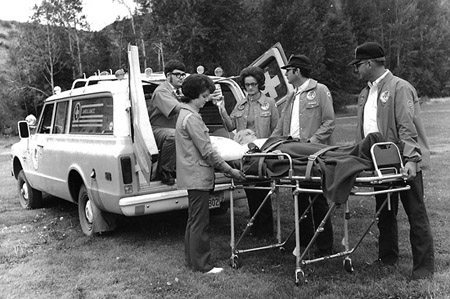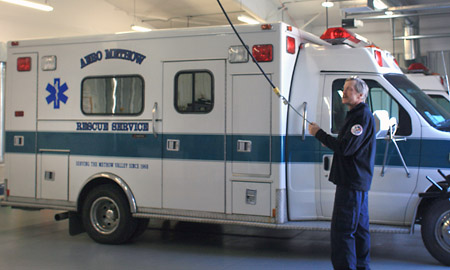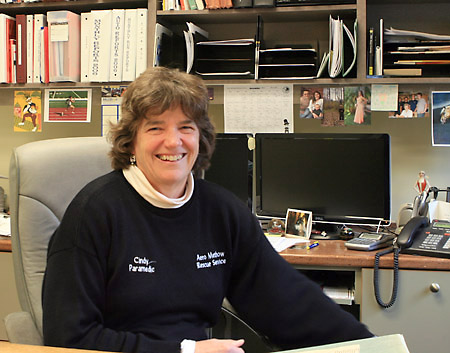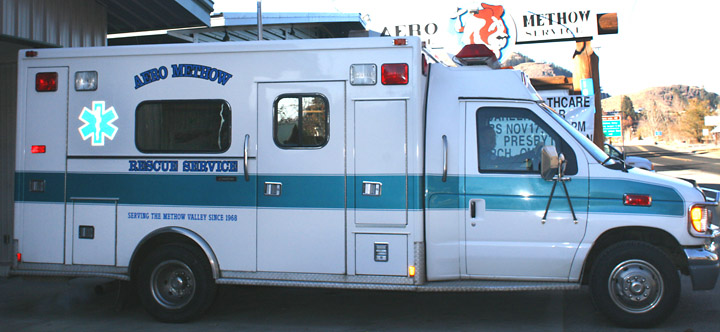home | internet service | web design | business directory | bulletin board | advertise | events calendar | contact | weather | cams

|
Aero Methow’s Road to Rescues  Aero Methow began with a donated Chevrolet Suburban makeshift ambulance. Aero Methow began with a donated Chevrolet Suburban makeshift ambulance. EMT Kurt Oakley, a former fireman, has been a volunteer with Aero Methow for three years. - Photo by Solveig Torvik EMT Kurt Oakley, a former fireman, has been a volunteer with Aero Methow for three years. - Photo by Solveig TorvikThe defining moment that led to the creation of today’s ever-ready Aero Methow Rescue Service in 1968 was an accident that trapped a woman under her car on Loup Loup Pass, according to Aero Methow executive director Cindy Button. Her father, Dr. William J. Henry, was a former U.S. Navy flight surgeon who had carried out search and rescue operations in the Aleutians and for 30 years afterwards served as the valley’s only doctor. His book, Pay You in Hay, recounts the special challenges he faced as a country doctor in the Methow. Dr. Henry responded to the accident in his car but once on the scene, couldn’t reach the patient to help her. He sent for a tow truck to come lift the car off the woman. “She died before he got there,” relates Button, 55, who says she remembers this as the incident that galvanized her father into establishing what was to become the modern emergency ambulance and rescue service she now heads. It’s a long way from the valley’s first donated Suburban makeshift ambulance to the fleet of high-tech vehicles now at ready to assist valley residents and visitors. Two ambulances are stationed at Aero Methow headquarters in Twisp, and there’s room to garage one more. One ambulance is kept in Winthrop, one in Mazama, and a smaller emergency vehicle is assigned to Carlton. Today Aero Methow assists hundreds of people in dire straits each year. In 2010, the service answered calls for help from 453 people, 360 of them valley residents and 93 non-residents. It has an operating budget of $700,000 a year. “We have a high cost of readiness,” says Button of her non-profit operation.  Cindy Button is executive director of Aero Methow. Her father started the service. - Photo by Solveig Torvik. Cindy Button is executive director of Aero Methow. Her father started the service. - Photo by Solveig Torvik.From the complement of 13 men and two women who comprised the rescue service’s first volunteers, Aero Methow has grown to have six full-time paid employees, three part-time employees, and 21 emergency medical technician (EMT) volunteers who are required to attend training once a month. The volunteers are on duty for a 12-hour shift four times per month. Aero Methow personnel are trained for three levels of assistance: basic EMT, advanced EMT - which means they can give life saving medications and start intravenous injections - and paramedics. Button may have been destined for the job she now holds. “I hated school with a passion,” she says. After her freshman year there, she refused to attend Twisp High School, which didn’t offer any of the science courses she wanted and was not accredited. In her sophomore year arrangements were made for her to attend Interlake High School on the west side. “It had every science course you could take. I loved it.” She went on to earn a degree in cardiac rehabilitation from the University of Washington. She married smokejumper John Button, who later would become the North Cascades Smokejumper Base manager. When in 1984 they returned to the valley, Button, who had previously been a volunteer with the rescue service and a physician’s helper to her father, became executive director of Aero Methow. The first ambulance was stationed at Dr. Henry’s Twisp clinic. Kay Wagner, widow of Twisp mill owner Otto Wagner, bought the second ambulance. But finding proper housing for the emergency service and its vehicles over time became a problem. By 1991, Button says, “We were orphans without a home or money.” Then Ken Westman from the Okanogan County Electric Co-op suggested that Aero Methow apply for a community development grant available at a 1 percent service fee through the co-op from a revolving loan fund sponsored by the U.S. Department of Agriculture. The application was approved, and by 1998, Aero Methow had three ambulances. It also built a garage to house them, plus an office building. To obtain sustainable funding to keep the service operating, Aero Methow became a junior taxing district in 1991, and taxpayers now provide 50 percent of its operating expenses. “We have to earn the other 50 percent,” says Button. Voters within the boundaries of Methow Valley School District 350 vote on 10-year levies for the Methow Valley Emergency Medical Services District, though the city council in Twisp decided its residents should vote every six years. The next 10-year levy will be placed before voters in 2013.
Sometimes donations arrive unexpectedly. “We rescued some people from Microsoft,” recalls Button. One of the climbers had broken a leg and it required difficult, highly technical maneuvers to bring the woman to safety. It just happened that an Aero Methow rescue team had been practicing for such an event, says Button. The woman’s boyfriend showed his appreciation with a $50,000 check. While the service does levy a charge for rescues based on an hourly rate for equipment, the fees don’t cover the expenses, are not covered by insurance, and are rarely paid, says Button. “We charge so people realize there is an expense with the hope that we can recover some costs.” Many of the people Aero Methow transports cannot pay for the service, Button says. “More people are asking for charity care,” she adds. “We continue to provide the service regardless of people’s ability to pay.” Twenty-seven percent of the service provided by Aero Methow is not reimbursed, according to Button. Last year that meant 6 percent of service expenses were written off for charity and hardship, or $19,721. In addition, Aero Methow wrote off $67,137 in charges that Medicare, Medicaid and insurance companies wouldn’t pay, says Button. It costs Aero Methow $1,200 to transport a patient needing life-support services from Twisp to the hospital, she explains. If a paramedic is not required to be aboard, transport with only EMT service to monitor vital signs costs $570. The ambulances are now 13 years old and need to be replaced, Button says. They cost $130,000 each. She hopes to raise the money from grants and donations, and is laying plans for fund-raisers so that these vehicles, which over the years have proven to be so vital to the community, can be replaced. 11/17/2011 |
 Aero Methow's ambulances are aging and need to be replaced. Cost is $130,000 each. - Photo by Solveig Torvik
Aero Methow's ambulances are aging and need to be replaced. Cost is $130,000 each. - Photo by Solveig Torvik